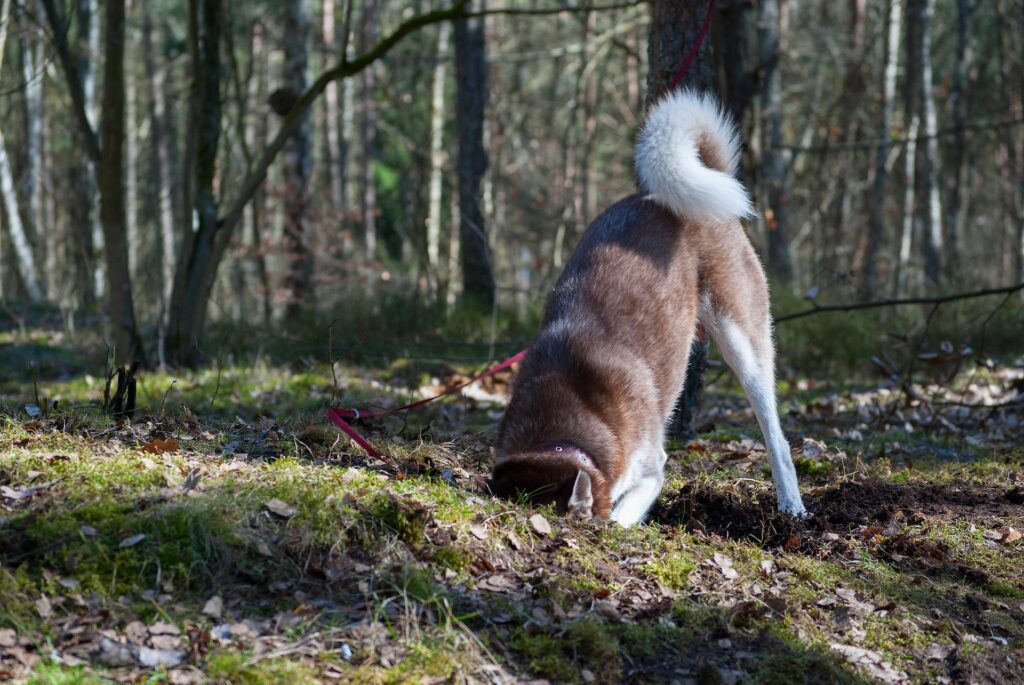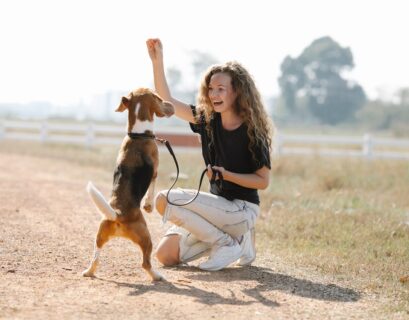“Unlocking the Canine Code: The Secret Language Your Dog Wants You to Know!”
Key Takeaways:
- Understand dog body language for a stronger bond.
- Facial expressions, tail wagging, and posture reveal emotions.
- Vocalizations like barks and whines express needs.
- Consider the environment and socialization for happy dogs.
- Special cases need patience and professional help.
- Positive reinforcement builds trust and connection.
- Foster emotional intelligence for empathy.
- Avoid anthropomorphism; dogs are unique.
- Promote responsible ownership and compassion.
- Embrace understanding your dog for a joyful relationship.
If you’ve ever found yourself puzzling over what your furry companion is trying to tell you, you’re certainly not alone. Dogs, our loyal and beloved friends, have an intricate language of their own—one that extends far beyond their playful barks and tail wags. Understanding their behavior becomes essential to the human-dog bond as we share our lives with these fascinating creatures. So, join us on a journey of discovery as we delve into the world of “Dog Behavior and Communication: Decoding Your Dog’s Body Language and Vocalizations.”
In this article, we’ll unravel the subtle nuances of canine communication, guiding you through the maze of facial expressions, tail wagging, and body movements that make up their unique language. Through this newfound insight, you’ll learn to decipher your dog’s feelings, moods, and intentions, forging a deeper connection built on trust and understanding.
Beyond the familiar barks that signal playfulness or protection, we’ll explore the rich tapestry of vocalizations that reveal much more about our furry friends’ emotions. Whimpers, whines, growls—they all have distinct meanings, and by learning to interpret them, you’ll be better equipped to respond to your dog’s needs with empathy and care.
But communication is a two-way street, and our interactions with dogs also play a vital role. Considering the environment and being mindful of their responses can create a harmonious and enriching experience for both parties. Whether you’re a seasoned dog owner or considering bringing a new canine companion, this article will provide practical insights and expert guidance to foster a positive and fulfilling relationship.
Dogs, just like us, have individual personalities and unique needs. We’ll explore special cases, such as rescue dogs and those displaying aggressive behavior, offering strategies to nurture their well-being and help them thrive. As we delve into the world of canine emotions, you’ll discover the power of emotional intelligence in dogs, proving that our four-legged friends are more in tune with our feelings than we might have imagined.
Addressing common misconceptions and debunking myths about dogs allowing you to appreciate their natural behaviors and avoid anthropomorphizing their actions. Instead, we’ll encourage positive reinforcement techniques and responsible ownership, empowering you to create a loving and supportive environment that brings out the best in your dog.
As the future unfolds, we’ll touch upon the latest advancements in canine behavioral studies, revealing exciting scientific insights that pave the way for better training methods and improved communication. And, in the spirit of responsible journalism, we’ll emphasize the importance of promoting awareness and education about proper dog care, ensuring that the world becomes a more compassionate and understanding place for our canine companions.
So, fellow dog lovers, prepare to embark on a journey of learning, compassion, and delight as we delve into “Dog Behavior and Communication: Decoding Your Dog’s Body Language and Vocalizations.” Together, we’ll build stronger bonds with our canine friends, fostering a relationship filled with love, respect, and the joy of understanding each other in ways words could never express.
Decoding Dog’s Body Language

Reading Facial Expressions
Eyes: The Window to Your Dog’s Emotions
Dogs convey a wealth of emotions through their eyes. Wide, relaxed eyes indicate a content and happy pup, while narrowed eyes can signal discomfort or unease. Dilated pupils may indicate excitement or fear, depending on the context. Understanding the subtle changes in eye expressions can help you gauge your dog’s emotional state and respond accordingly.
Ears: Listening to Your Dog’s Inner Voice
A dog’s ears are highly expressive and can offer valuable insights into their mood. Perked ears often suggest curiosity or attentiveness, while flattened ears might indicate fear or submission. Additionally, ears pulled back may signal anxiety or stress. Learning to interpret these ear movements can enhance your ability to communicate effectively with your canine companion.
Mouth and Lips: The Language of Canine Communication
A dog’s mouth and lips can reveal a spectrum of emotions. A relaxed, slightly open mouth typically indicates a calm and happy dog. Conversely, lips pulled back and bared teeth can be signs of fear or aggression. Yawning may not always mean tiredness; it can also signify stress. Observing these mouth and lip cues can provide vital clues about your dog’s emotional well-being.
Understanding Tail Wagging
Different Types of Tail Wagging and What They Mean
Contrary to popular belief, tail wagging is not always a sign of a happy dog. Different tail wags convey various emotions. A broad, sweeping wag with a relaxed body suggests joy and excitement. However, a stiff, rapid wag with a raised tail may indicate alertness or agitation. Understanding the nuances of tail wagging allows you to respond appropriately to your dog’s feelings.
Tail Positions and Their Meanings
The position of a dog’s tail can reveal a lot about its emotions. A high-held tail is often a sign of confidence, while a tucked tail signifies fear or submission. A wagging tail held at a neutral height usually indicates a friendly disposition. By paying attention to your dog’s tail, you can gain valuable insights into their mood and help them feel understood and secure.
Posture and Body Movements
Playful Behavior: Reading the Joyful Dance
When dogs engage in play, they exhibit specific body movements that convey their excitement. A play bow, where the front end lowers with the rear end raised, invites frolic. Playful movements like bounding, bouncing, and darting are also common. Understanding these gestures ensures you can join the fun and create lasting bonding moments.
Submissive Gestures: Recognizing Vulnerability
In the canine world, displaying submissive behaviors is a way for dogs to avoid conflict. These gestures include crouching, rolling over, or tucking the tail. Submissive dogs may also avert their gaze or lick their lips as a sign of appeasement. Recognizing these signals is essential for fostering a safe and secure environment for your dog.
Signs of Aggression: Navigating Canine Warning Signs
Identifying the early signs of aggression is crucial for preventing potential confrontations. Raised hackles, direct staring, and stiff body posture are common indicators of a dog feeling threatened. Growling, snarling, and showing teeth can escalate aggression if not addressed appropriately. Understanding these signs allows you to avoid potential conflicts and ensure everyone’s safety proactively.
Interpreting Dog’s Vocalizations

Barks and Their Meanings
Alert Barks: Guarding Their Territory
When your dog barks in short, repetitive bursts, they are likely alerting you to something unusual or threatening in their surroundings. This instinctual behavior refers to their ancestry as protectors of their pack or territory.
Playful Barks: Inviting Fun and Frolic
A different tone of bark, often accompanied by a wagging tail and playful body language, indicates your dog’s desire for playtime. These barks convey enthusiasm and eagerness to engage in activities with you.
Territorial Barks: Defending Their Space
Territorial barking is a dog’s way of asserting ownership of their living space. When someone or something encroaches on their territory, your dog may bark persistently to ward off potential intruders.
Whines, Whimpers, and Moans
Expressing Anxiety or Fear: Seeking Reassurance
Dogs may emit whining or whimpering sounds when they feel anxious, scared, or unsure about a situation. These vocalizations are their way of communicating a need for comfort and reassurance from their human companions.
Seeking Attention or Comfort: Vocal Pleas for Interaction
Sometimes, dogs use whines and moans to get your attention or express their desire for interaction. They might seek cuddles, playtime, or extra love and affection.
Growls and Snarls
Warning Signs of Aggression: Navigating Potential Danger
Growls and snarls are vocalizations that dogs use to communicate their discomfort or displeasure. These sounds serve as warning signs, and it’s crucial to respect your dog’s boundaries and investigate the cause of their distress.
Defensive Growls versus Playful Growls: Differentiating Tones
Not all growls are aggressive; some dogs playfully growl during interactive play sessions. Understanding the context and accompanying body language will help you distinguish between playful vocalizations and those indicating possible aggression.
Context and Communication
Considering the Environment
Tailoring Communication to Surroundings
Dogs are highly attuned to their environment, and their behavior may vary depending on where they find themselves. Understanding how to adjust your communication and expectations based on the setting can lead to smoother interactions and a more comfortable experience for your dog. For instance, a crowded urban environment might require a different approach than a peaceful rural setting, where your dog can freely explore and feel at ease.
Responses to Urban versus Rural Settings
In urban areas, where stimuli and noise are abundant, dogs may exhibit higher levels of stress or agitation. Recognizing signs of discomfort and employing strategies to mitigate potential stressors can enhance your dog’s well-being in the city. Conversely, rural settings may offer more opportunities for exploration and off-leash adventures, promoting a sense of freedom and contentment.
Interaction with Humans and Other Animals
Recognizing Fear in Dogs
Dogs may display subtle signs of fear when encountering unfamiliar people or animals. Raised hackles, lowered body posture, or attempts to retreat indicate that your dog might feel uneasy. Understanding fear-related cues can help you respond with patience and empathy, gradually building your dog’s confidence in social situations.
Promoting Positive Socialization
Socialization is a crucial aspect of a dog’s life. Encouraging positive interactions with other dogs and humans during their formative stages helps build their social skills and confidence. When introducing your dog to new environments or interactions, creating positive associations through treats, praise, and patience can significantly affect their comfort level.
Special Cases: Dogs with Specific Needs

Rescue Dogs and Trauma
Signs of Past Abuse or Neglect
Rescue dogs, especially those with a history of mistreatment, may display unique body language cues that reflect their past trauma. Timid behavior, cowering, or recoiling at sudden movements are signs of a troubled past. You can help your rescue dog heal and learn to trust again by providing a nurturing and secure environment.
Building Trust and Confidence
Patience and consistency are essential when working with rescue dogs. Building trust takes time, and understanding their communication signals is paramount in creating a safe space for them to heal emotionally. Positive reinforcement, gentle handling, and gradual exposure to new experiences can help your rescue dog regain confidence and adapt to a loving home.
Dealing with Aggressive Behavior
Identifying Triggers
Aggression in dogs can arise from various triggers, such as fear, resource guarding, or territorial instincts. Recognizing these triggers is crucial in addressing aggressive behavior effectively. Identifying the root cause allows you to implement targeted strategies to manage and modify your dog’s response.
Seeking Professional Help
In cases of severe aggression or when you feel overwhelmed in dealing with your dog’s behavior, seeking the assistance of a professional dog trainer or animal behaviorist is essential. These experts can provide personalized guidance and training techniques to address aggression safely and compassionately.
Understanding your dog’s body language and vocalizations lays the foundation for a profound and fulfilling relationship. It enables you to respond empathetically to their needs, ensuring they feel understood, valued, and loved.
Nurturing Effective Communication
Building a Strong Bond
Importance of Training and Socialization
Training and socialization are fundamental aspects of nurturing effective communication with your dog. Positive reinforcement-based training methods teach commands and foster trust and cooperation between you and your dog. Socializing your furry friend from a young age helps them become well-adjusted and confident in various situations, making their interactions with people and other dogs smoother and more enjoyable.
Positive Reinforcement Techniques
Positive reinforcement, such as rewarding good behavior with treats, praise, or play, creates a harmonious and trusting relationship with your dog. By focusing on encouraging the behaviors you want to see and rewarding them, your dog will be more likely to repeat those desirable actions.
Encouraging Emotional Intelligence in Dogs
Recognizing Empathy in Dogs
Dogs have a remarkable capacity for empathy, often sensing and responding to their human companion’s emotions. They can offer comfort during distress or anxiety and celebrate moments of happiness with exuberance. Acknowledging and appreciating your dog’s empathetic nature strengthens the emotional bond between you and encourages them to be even more attuned to your emotional needs.
Enhancing Emotional Connection
Promoting emotional connection involves spending quality time with your dog, engaging in activities that bring you joy, and being attuned to their emotional cues. Through regular play, grooming sessions, and one-on-one interactions, you deepen your emotional connection, allowing you to understand your dog on a deeper level.
Misconceptions and Common Mistakes

Anthropomorphism: Understanding Dogs as Dogs
Avoiding Misinterpretations
Anthropomorphism, or attributing human characteristics to dogs, can lead to misinterpretations of their behavior. Remember that dogs have their own unique ways of expressing themselves, and it is essential to recognize and appreciate their canine nature.
Recognizing Natural Canine Behaviors
Understanding natural canine behaviors helps you appreciate and respect your dog’s instincts and responses. Acknowledging and accepting their inherent traits can foster a more balanced and positive relationship with your dog.
Punishment versus Positive Correction
Negative Effects of Punitive Training
Punishment-based training methods can lead to adverse consequences, such as fear, anxiety, and aggressive behavior in dogs. Opting for positive correction and reinforcing desired behaviors is a more effective and compassionate way to guide your dog’s behavior.
Emphasizing Positive Methods
By focusing on positive reinforcement and reward-based training, you create an environment where your dog feels safe, motivated, and eager to learn. Encouraging good behavior through praise and rewards strengthens the bond between you and your dog while building their confidence and trust.
The Future of Dog Communication
Advancements in Canine Behavioral Studies
Scientific Understanding of Dog Behavior
Ongoing research in canine behavioral studies sheds new light on how dogs communicate and interpret human cues. Scientific discoveries are helping us refine our knowledge of dog behavior, paving the way for more effective training methods and improved communication with our furry companions.
Applications in Training and Communication
As we continue to learn more about canine behavior, this knowledge can be applied to develop innovative training techniques that better address specific behavioral issues in dogs. These advancements also contribute to our ability to understand and interpret our dogs’ needs, ultimately enhancing the human-dog bond.
Promoting Responsible Dog Ownership
Spreading Awareness and Education
Promoting responsible dog ownership involves raising awareness about understanding and respecting canine behavior. We can create a society that fosters positive and loving relationships with our four-legged friends by providing education on proper care, training, and communication.
Fostering Respect for Our Canine Companions
Respecting and cherishing our dogs as valued family members rather than mere possessions leads to compassionate and empathetic treatment. By nurturing a culture that values the well-being of dogs and acknowledges their emotional needs, we can create a world where every dog thrives and feels cherished.
Conclusion
In conclusion, decoding your dog’s body language and vocalizations is a journey of exploration, understanding, and love. You’ll unlock the secrets of your dog’s emotions and intentions by attentively observing their expressions, gestures, and vocal cues. Recognizing and respecting their unique communication methods will create a deeper bond and a more profound emotional connection.
You can ensure your dog feels secure, cherished, and heard through positive reinforcement, empathy, and responsible ownership. Remember that every dog is an individual with his or her personality and needs. Each interaction with your dog provides an opportunity to deepen your bond and refine your communication skills. Through patience, love, and open-heartedness, you’ll build a relationship built on trust and mutual respect.
You become their confidant, protector, and most cherished friend by decoding your dog’s body language and vocalizations. You’ll be able to anticipate their needs, offer support during challenging times, and celebrate their happiness in moments of joy.
As you navigate the complexities of canine communication, it’s important to be forgiving of yourself and your dog. Mistakes are bound to happen, but with every challenge, you’ll gain insights that contribute to the growth of your relationship.
Moreover, the journey as a dog owner extends beyond the confines of your home. Be an ambassador for responsible dog ownership, spreading awareness and education to others in your community. Encourage kindness and compassion towards all dogs, regardless of breed or background. By promoting a culture of empathy and understanding, you contribute to a world where dogs are valued members of society.
In the ever-evolving world of canine behavioral studies, we can look forward to further revelations about our canine companions. Scientific advancements will deepen our understanding of their emotional intelligence, cognition, and complex social dynamics. As we incorporate these findings into our approach to dog care, we can continue to improve the lives of our furry friends.
Being a devoted dog owner is not just about providing food, shelter, and medical care. It’s about forging a connection that transcends words, where actions and gestures speak louder than any language. It’s about opening your heart to the unconditional love and boundless joy dogs bring.








